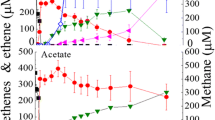Abstract
An anaerobic consortium taken from brackish sediments, enriched byPCE/CH3OH sequential feeding, was capable of completely dechlorinating tetrachloroethene(PCE) to ethene (ETH). In batch experiments, PCE (0.5 mM) was dechlorinated to ethene (ETH) in approximately 75 h with either CH3OH or H2 as the electron donor. When VC (0.5 mM) was added instead of PCE it was dechlorinated without any initial lag by the PCE/CH3OHenriched consortium, although at a lower dechlorination rate. In batch tests H2 could readilyreplace CH3OH for supporting PCE dechlorination, with a similar PCE dechlorination rate andproduct distribution with respect to those observed with methanol. This indicates that H2 productionduring CH3OH fermentation was not the rate-limiting step of PCE or VC dechlorination.Acetogenesis was the predominant activity when methanol was present. A remarkable homoacetogenicactivity was also observed when hydrogen was supplied instead of methanol.
Similar content being viewed by others
References
Aulenta F, Majone M, Di Pinto AC, Tomei MC & Tandoi V. (2001) Reductive dechlorination of perchloroethene to ethene by microbial consortia in sediments. Proceedings of 9th World Congress on Anaerobic Digestion. Antwerpen, 2: 239-244
Ballapragada BS, Stensel DH, Puhakka JA & Ferguson JF (1997) Effect of hydrogen on reductive dechlorination of chlorinated ethenes. Environ. Sci. Technol. 31: 1728-1734
Berbenni P (1994) La contaminazione delle acque sotterranee da parte di composti organici ed inorganici. Inquinamento 5: 50-59
Carr CS & Hughes JB (1998) Enrichment of high-rate PCE dechlorination and comparative study of lactate, methanol, and hydrogen as electron donors to sustain activity. Environ. Sci. Technol. 32: 1817-1824
Carter SR & Jewell WJ (1993) Biotransformation of tetrachloroethylene by anaerobic attached-films at low temperature. Wat. Res. 4: 607-615
Cord-Ruwisch R & Ollivier B (1986) Interspecific hydrogen transfer during methanol degradation between Sporomusa acidovorans and hydrogenophilic anaerobes. Arch. Microbiol. 144: 163-165
De Bruin WP, Kotterman JJ, Posthumus MA, Schraa G & Zehnder AJB (1992) Complete biological transformation of tetrachloroethene to ethane. Appl. Environ. Microbiol. 58(6): 1996-2000
DiStefano TD, Gossett JM & Zinder SH (1991) Reductive dechlorination of high concentration of tetrachloroethene to ethene by an anaerobic enrichment culture in absence of methanogenesis. Appl. Environ. Microbiol. 57: 2287-2292
DiStefano TD, Gossett JM & Zinder SH (1992) Hydrogen as an electron donor for dechlorination of tetrachloroethene by an anaerobic mixed culture. Appl. Environ. Microbiol. 58: 3622-3629 424
Fennel DE, Gossett JM & Zinder SH (1997) Comparison of butyric acid, ethanol, lactic acid, and propionic acid as hydrogen donors for the reductive dechlorination of tetrachloroethene. Environ. Sci. Technol. 31: 918-926
Freedman D & Gossett JM (1989) Biological reductive dechlorination of tetrachloroethylene and trichloroethylene to ethylene under methanogenic conditions. Appl. Environ. Microbiol. 55: 2144-2151
Gao J, Skeen RS, Hooker BS & Quesenberry RD (1997) Effect of several electron donors on tetrachloroethylene dechlorination in anaerobic soil microcosms. Wat. Res. 31(10): 2479-2486
Gossett JM (1987) Measurement of Henry's law constants for C1 and C2 chorinated hydrocarbons. Environ. Sci. Technol. 21: 202-208
Haston ZC & McCarty PL (1999) Chlorinated ethene half-velocity coefficients (KS ) for reductive dehalogenation. Environ. Sci. Technol. 33: 223-226
He J, Sung Y, Dollhopf ME, Fathepure BZ, Tiedje JM & Löffler FE (2002) Acetate versus hydrogen as direct electron donors to stimulate the microbial reductive dechlorination process at chloroethene-contaminated sites. Environ. Sci. Technol. 36: 3945-3952
Komatsu T, Shinmyo J & Momonoi K (1997) Reductive transformation of tetrachloroethylene to ethylene and ethane by an anaerobic filter. Wat. Sci. Tech. 36(6-7): 125-132
Kotsyurbenko OR, Glagolev MV, Nozhevnikova AN & Conrad R (2001) Competition between homoacetogenic bacteria and methanogenic archea for hydrogen at low temperature. FEMS Microbiology Ecology 38: 153-159
Mazur CS & Jones JW (2001) Hydrogen concentration in sulphatereducing estuarine sediments during PCE dehalogenation. Environ. Sci. Technol. 35: 4783-4788
Maymò-Gatell X, Tandoi V, Gossett JM & Zinder SH (1995) Characterisation of an H2-utilizing anaerobic enrichment culture that reductively dechlorinates tetrachloroethene to vinyl chloride and ethene in complete absence of methanogenesis and acetogenesis. Appl. Environ. Microbiol. 61: 3928-3933
Maymó-Gatell X, Chien YT, Gossett JM & Zinder SH (1997) Isolation of a bacterium that reductively dechlorinates tetrachloroethene to ethene. Science 276: 1568-1571
Middeldorp PJM, Luijten MLGC, van de Pas BA, van Eekert MHA, Kengen SWM, Schraa G & Stams AJM (1999) Anaerobic microbial reductive dechlorination of chlorinated ethenes. Bioremediation Journal 3: 151-169
Pavlostathis SG & Giraldo-Gomez E (1991) Kinetics of anaerobic treatment. Wat. Sci. Tech. 24: 35-59
Peters V, Janssen PH & Conrad R (1998) Efficiency of hydrogen utilization during unitrophic and mixotrophic growth of Acetobacterium woodii on hydrogen and lactate in the chemostat. FEMS Microbiology Ecology 26: 317-324
Ryoo D, Shim H, Canada K, Barbieri P & Wood TK (2000) Aerobic degradation of tetrachloroethylene by toluene-o-xylene monooxygenase of Pseudomonas stuzeri OX1. Nature Biotechnology 18: 775-778
Rossetti S, Blackall LL, Majone M, Hugenholtz P, Plumb JJ & Tandoi V (2003) Kinetic and molecular characterization of an anaerobic dechlorinating microbial community. Microbiology 149: 459-469.
Smatlak CR, Gossett JM & Zinder SH (1996) Comparative kinetics of hydrogen utilization for reductive dechlorination of tetrachloroethene and methanogenesis in an anaerobic enrichment culture. Environ. Sci. Technol. 30: 2850-2858
Tandoi V, DiStefano TD, Bowser PA, Gossett JM & Zinder SH (1994) Reductive dehalogenation of chlorinated ethenes and halogenated ethanes by a high rate anaerobic enrichment culture. Environ. Sci. Technol. 28: 973-979
Vogel TM, Criddle CS & McCarty PL (1987) Transformation of halogenated aliphatic compounds. Environ. Sci. Technol. 21: 722-736
Yang Y & McCarty PL (1998) Competition for hydrogen within a chlorinated solvent dehalogenating anaerobic mixed culture. Environ. Sci. Technol. 32: 3591-3597
Author information
Authors and Affiliations
Rights and permissions
About this article
Cite this article
Aulenta, F., Majone, M., Verbo, P. et al. Complete dechlorination of tetrachloroethene to ethene in presence of methanogenesis and acetogenesis by an anaerobic sediment microcosm. Biodegradation 13, 411–424 (2002). https://doi.org/10.1023/A:1022868712613
Issue Date:
DOI: https://doi.org/10.1023/A:1022868712613




